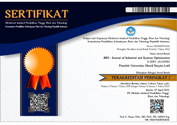ANALISIS PENENTUAN REMAINING LIFE DENGAN PENDEKATAN METODE RBI SEMI KUANTITATIF (STUDI KASUS PADA PIPA PENYALUR GAS BAWAH TANAH DI PT. XYZ)
DOI:
https://doi.org/10.51804/jiso.v4i2.88-95Keywords:
Corrosion rate, natural gas, rbi, remaining life, riskAbstract
PT. XYZ is a natural gas trading company that was founded in 2003 and started to expand its business to East Java starting in 2012 with a total length of 18 KM pipeline. This study aims to determine what risks exist in the natural gas pipeline network and determine the remaining service life (Remaining Life) of the pipeline that can be used. The method used is by using a Risk Based Inspection (RBI) semi-quantitative method approach to determine the most risky sections and with ASME B.31.8 and API 570 standards for determining the nominal thickness and requirement thickness of the pipe to determine the remaining service life (Remaining Life) of the pipe. distributor. From the results of the study, it is known that several risks exist in the pipeline segment, including life risk, financial risk, environmental risk, social risk, legal risk and business continuity. Based on these risks, it can be seen that the ML-02 Pipe Section is the most risky section. In accordance with calculations with ASME B31.8 and API 570 standards based on pipe thickness and corrosion rate, the Remaining Life for Section ML-02 is the shortest, which is 15.42 Years. Referring to the calculation results on the ML-02 pipe section, if the average reduction in pipe thickness is calculated each year, the results show that the ML-02 pipe section at Point A, namely the Box Valve Pipe at the Bambe Village Office (BV02/ML02) is the most common. reduction in pipe thickness is 0.13 millimeters / year and has a shorter Remaining Life, which is 10.97 Years.
Abstrak
PT. XYZ merupakan salah satu badan usaha niaga gas alam yang mulai didirikan pada tahun 2003 dan mulai mengembangkan bisnisnya ke Jawa Timur mulai tahun 2012 dengan total panjang pipa penyalur sepanjang 18 KM. Penelitian ini bertujuan untuk menentukan risiko apa saja yang ada pada jaringan pipa penyalur gas alam dan menentukan sisa umur layan (Remaining Life) pipa penyalur tersebut dapat dipergunakan. Metode yang digunakan yaitu dengan menggunakan Risk Based Inspection (RBI) pendekatan metode semi kuantitatif untuk penentuan ruas yang paling berisiko dan dengan standar ASME B.31.8 dan API 570 untuk penentuan nominal thickness dan requirement thickness pipa untuk menentukan sisa umur layan (Remaining Life) pipa penyalur. Dari hasil penelitian diketahui bahwa beberapa risiko yang ada pada ruas pipa penyalur antara lain risiko jiwa, risiko finansial, risiko lingkungan, risiko sosial, risiko legal dan keberlangsungan bisnis. Berdasar risiko tersebut maka dapat diketahui bahwa Ruas Pipa ML-02 merupakan ruas yang paling berisiko. Sesuai perhitungan dengan standar ASME B31.8 dan API 570 berdasar ketebalan dan laju korosi pipa, maka Remaining Life untuk Ruas ML-02 adalah yang paling pendek yaitu selama 15,42 Tahun. Mengacu pada hasil perhitungan pada ruas pipa ML-02, jika dihitung rata-rata pengurangan ketebalan pipa tiap tahunnya, didapatkan hasil bahwa ruas pipa ML-02 pada Titik A yaitu pada Pipa Box Valve Kantor Desa Bambe (BV02/ML02) yang paling banyak terjadi pengurangan ketebalan pipa yaitu 0,13 milimeter / tahun dan memiliki Remaining Life yang lebih pendek, yaitu selama 10,97 Tahun.
References
API 570 4th 2016 (2016) API 570, Piping Inspection Code : In-service Inspection , Rating , Repair , and Alteration of Piping Systems. 4th edn. American Petroleum Institute.
B31.8, A. (2018) ASME B31.8 Gas Transmission and Distribution Piping Systems. B31.8, The American Society of Mechanical Engineering. B31.8. New York.
Haryadi, G. D. (2020) ‘Analisa Risiko Dan Prediction Remaining Lifetime Pada Pipa Gas Lurus Ø 14” Meng Gunakan Metode Risk Based Inspection Berdasarkan Api 581’, 3(1), pp. 1–11.
Hendrayansah, H. (2019) ‘Studi Implementasi Risk Based Inspection (Rbi) Berdasarkan Pada Api 580 dan Api 581 DI SPG Merbau Field Prabumulih, Asset 2 PT Pertamina EP’.
Nurkholis, N. and Adriansyah, G. (2017) ‘Pengendalian Bahaya Kerja Dengan Metode Job Safety Analysis Pada Penerimaan Afval Lokal Bagian Warehouse Di Pt. St’, Teknika: Engineering and Sains Journal, 1(1), p. 11. doi: 10.51804/tesj.v1i1.63.11-16.
Nuswantoro, B. (2018) ‘Analisis Remaining Life Dan Program Inspeksi Dengan Pendekatan Risk Management Pada Pipa Penyalur Gas’, Prosiding SNST Fakultas Teknik, 1(1).
Purba, M. L., Budiasih, E. and Atmaji, F. T. D. (2020) ‘Usulan Optimasi Interval Inspeksi dan Estimasi Remaining Life pada Pressure Vessel Menggunakan Metode Risk Based Inspection (RBI) Dengan Pendekatan Semi-Kuantitatif’.
Ratnasari, P., Alhilman, J. and Pamoso, A. (2019) ‘Penilaian Risiko, Estimasi Interval Inspeksi, dan Metode Inspeksi pada Hydrocarbon Piping Menggunakan Metode Risk Based Inspection (RBI)’, Jurnal INTECH Teknik Industri Universitas Serang Raya, 5(2), pp. 67–74.
Downloads
Published
Issue
Section
License
With the receipt of the article by JISO Editorial Board and the decision to be published, the copyright regarding the article will be transferred to JISO. The copyright transfer form can be downloaded here.
JISO has the right to multiply and distribute the article and every author is not allowed to publish the same article that was published in this journal.
JISO is licensed under a Creative Commons Attribution-ShareAlike 4.0 International License.
Under the following terms:
Attribution — You must give appropriate credit, provide a link to the license, and indicate if changes were made. You may do so in any reasonable manner, but not in any way that suggests the licensor endorses you or your use.
ShareAlike — If you remix, transform, or build upon the material, you must distribute your contributions under the same license as the original.














